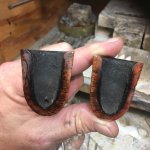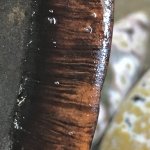Every pipe smoker hates breaking in a new pipe and every pipe maker knows it.I won't buy a pipe without a proper bowl coating, I hate breaking in new un-coated briar.
The few of us immersed in the cult of Pipes by Lee know (or at least have sure and certain faith) that any Lee pipe is still a pleasure to the taste buds to break in,,,
But even a Lee gets hot and smells like briar during break in, although the smoke tastes sweet.
The maker can only do two things to help a customer through the break in period.
He can somehow boil or otherwise treat the briar using methods invisible to the customer, like Lee did.
Otherwise he’s got to devise a bowl coating.
I recently got in an old generic large billiard from France that had an extremely thick cake. I not only took all that cake out, but I used steel wool and Everclear to make the chamber brown again.
At the very bottom of the chamber I caught a taste of briar and the pipe got hot for a few smokes, until the briar was totally broken in.
Harry Hosterman smoked Dr Grabow pipes that had been machine broken in.
The rest of us need to trust the maker’s judgement of what slurry they apply is the best way to get through the break in process of heat curing out the briar.









